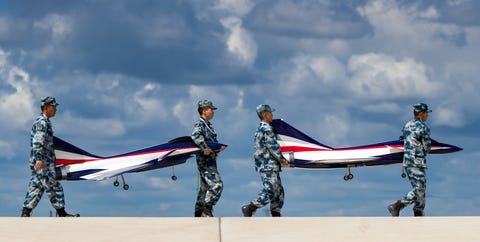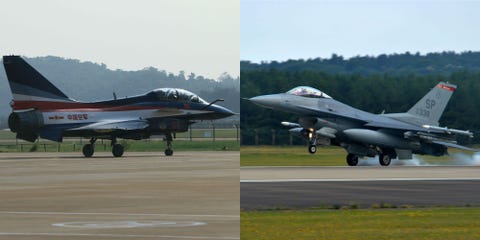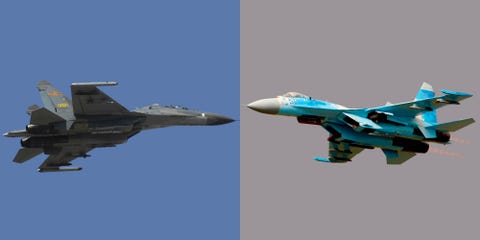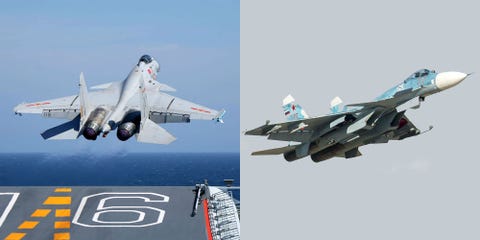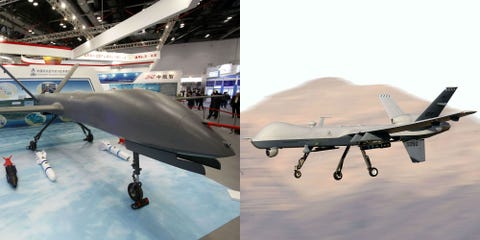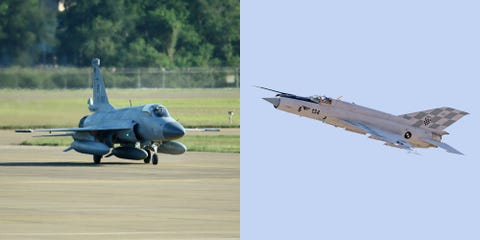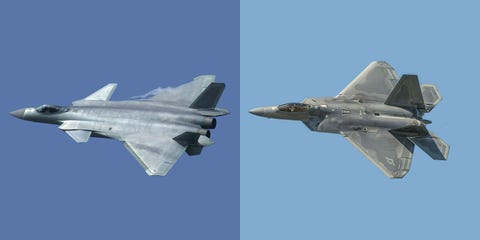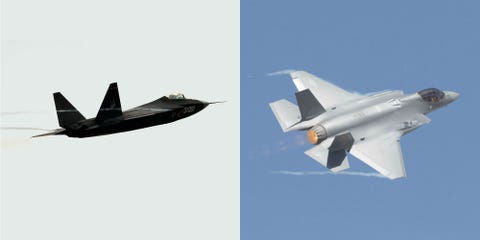Its not just from Us china is stealing. They even copy russian fighter jet design amd engines.plus forced european companies to jv in high speed trains and planes manufacturing only to copy it later on.
Counterfeit Air Power: Meet China's Copycat Air Force
China went from a regional to world power in record time, but it needed some "help" along the way.
BY
ALEX HOLLINGS
SEP 19, 2018
VCGGETTY IMAGES
As China’s world influence expands, so is its military. An
increasingly capable Navy, large
investments in weapons tech, and
its first overseas military base speak to President Xi Jinping’s goal to make China a global superpower.
But to match that ambition, the People’s Liberation Army (PLA) has turned to other countries for “inspiration” when it comes to outfitting its armed forces. Although buying or stealing foreign military technology could be seen as a strategic weakness, China skips expensive and time-consuming R&D.
And nowhere is fast-and-loose weapons adoption (and its inherent shortcomings) more apparent than in China’s Air Force. Like the U.S, China deploys aircraft with a broad range of capabilities, but unlike the U.S. most of China’s planes are based on plans purchased or stolen from its adversaries. Here are seven of them.
ADVERTISEMENT - CONTINUE READING BELOW
Chengdu J-10 and U.S. F-16
VCG AND USAF PHOTOGETTY IMAGES
In the 1980s, the U.S. partnered with Israel to develop a new combat aircraft based on the General Dynamics F-16. But as costs rose, the U.S. pulled out of the deal, leaving Israel’s “Lavi” fighter unfinished.
Years later American officials discovered that Israel sold the Lavi’s development plans to China, granting them unprecedented access to technologies first developed for the F-16.
The J-10 shared more than a striking visual resemblance with the F-16. The technology sourced through Israel allowed China to advance significantly over the 1960s era fighters they were fielding at the time. This would not be the last Chinese fighter to incorporate elements of the F-16, but it's the most direct.
An updated version of the J-10 entered into service last year with an advanced fire control radar array, an increased use of composite materials to reduce weight, and a number of other domestically developed updates that aim to keep the J-10 capable for decades to come.
Shenyang J-11/16 and Russian Sukhoi Su-27
USAF AND AIRWOLFHOUNDWIKIMEDIA COMMONS
As the Soviet Union neared collapse in 1989, China seized the opportunity to secure the production line for the Sukhoi Su-27, an air superiority fighter developed to counter American jets like the T-14 Tomcat. The Soviets, keen to sell China a new MiG design instead, were left with little choice in the face of looming economic ruin.China quickly set about producing their own Su-27s, and then improving upon the design to develop what would become the J-11.
Unlike other fighters China employed at the time, the Su-27 brought advanced avionics systems and fly-by-wire technology that China was also able to incorporate into later platforms.
In 2000, Russia sold China a number of advancements they’d made to their own Su-27 platform, and China’s subsequent effort to incorporate them alongside domestically developed technologies has since resulted in the the J-16—a modified and updated Su-27.
ADVERTISEMENT - CONTINUE READING BELOW
Shenyang J-15 and Russian Sukhoi Su-33
VCG AND DMITRY TEREKHOV/WIKIMEDIA COMMONSGETTY IMAGES
China’s J-15 serves as their primary carrier based aircraft, and if China had gotten their way, it would have been produced originally by simply
purchasing the production line for the Su-33 (which is Russia’s carrier-capable version of the Su-27).
When the Soviets refused to part with their Su-33 design secrets, China purchased an Su-33 prototype aircraft from Ukraine, dubbed the T-10K-3, and quickly set about reverse engineering it.
The result is a carrier-based fighter that shares the Su-33’s folding wing design and overall appearance coupled with a few Chinese improvements like incorporating more composite materials to reduce overall weight.
Technically speaking, the J-15 could be considered the superior fighter to America’s long serving (and fastest) intercept fighter, the F-15—at least on paper. With a faster top speed, greater maximum G-load, and slightly higher operational ceiling, China has been happy to contend that a dog fight between the two jets would undoubtedly result in a Chinese victory;
But the J-15 is severely hindered by its launch apparatus. China’s dated Liaoning carrier’s inferior catapult and ramp system to launch fighters severely limits the maximum operational weight of the J-15, reducing the total ordnance it can take into fight. New carriers under development promise to offer an electromagnetic catapult similar to those used on America’s new Ford class carriers, but the J-15 may not live to see service on such a ship.
ADVERTISEMENT - CONTINUE READING BELOW
CASC Caihong-4 and U.S. MQ-9 Reaper
VCG AND ISAAC BREKKENGETTY IMAGES
While there is no definitive publicly available evidence to support America’s claims that China’s Caihong-4 (CH-4) armed drone is based on stolen plans for the General Atomics MQ-9 Reaper, seeing is believing. The resemblance is striking but similarities are only skin deep
Despite clearly being
modeled after the American UAV, the CH-4 boasted fewer outboard stations for mounted ordnance while delivering
comparable flight characteristics and duration, suggesting that it’s propulsion system is not as capable as those fielded on the Reaper.
However, China promptly set about working to match the Reaper’s capability within their own drone program, leading to the newer and more robust CH-5, which is an updated version of their first attempt at copying the American platform.
FC-1 Xiaolong and Soviet MiG-21
VCG AND TOMISLAV MARAMINČIĆ/WIKIMEDIA COMMONSGETTY IMAGES
China’s love affair with Russian fighters doesn’t only include Sukhoi designs. In the 1960s, China purchased production plans for the Mikoyan-Gurevich MiG-21, which was modified and updated into China’s J-7 platform. In the years since, that J-7 became the basis for a new joint venture with Pakistan that aimed to field a new fighter that could compete with a different MiG—the newer Soviet MiG-29.
Thanks to China’s access to F-16 design specs through Israel’s “Lavi” program, that
joint venture resulted in an amalgamation of F-16 and Mig-21 characteristics, creating an aircraft that some contend is greater than the sum of its parts. Elements of both aircraft can be seen in the FC-1 (JF-17 in Pakistan), with the F-16’s nose and tail joined by a distinctly MiG-21 wing design.
This plane continues to fly today, and is by many accounts a fighter that can stand toe-to-toe with jets designed decades after it first flew.
The newest iterations of the JF-17 now include air-to-air refueling capabilities, greater use of composite materials to reduce weight, and fly-by-wire technology first procured through a different Soviet purchase.
ADVERTISEMENT - CONTINUE READING BELOW
Chengdu J-20 and U.S. F-22 Raptor
ALERT5 AND USAFWIKIMEDIA COMMONS
The J-20, China’s first fifth generation fighter, was purpose built not only to serve as a competitor for America’s F-22 Raptor, but in many ways, as a direct copy. Plans for the Lockheed Martin design were stolen by a Chinese national named Su Bin, who was
sentenced to 46 months in federal prison for his crime. The repercussions of his efforts on behalf of the Chinese government will live on for decades.
Aside from the obvious addition of forward canards on the J-20, the two aircraft look nearly identical thanks to China’s access to classified F-22 development data, but as is often the case, the similarities seem to end with the aesthetic.
Because China lacks extensive background in stealth technology, it’s widely believed that the J-20’s stealthy design is limited by their inferior radar-absorbant coating, production materials, and even those tell-tale canards (which some believe will have an adverse effect on its stealth profile).
American defense experts have
said that China’s J-20 will have a far larger radar signature than the F-22, but other variables may ultimately render any American advantages moot. The U.S. canceled the F-22 program in 2011 with fewer than 200 built. China, on the other hand, will continue to produce J-20s in large quantities for years to come.
Shenyang J-31 and the U.S. F-35
VCG AND YICHUAN CAO/NURPHOTOGETTY IMAGES
Like the F-22, Lockheed Martin’s F-35 Joint Strike Fighter was also
compromised by Su Bin, leading to China’s J-31 program. This jet, still under development, possesses a greater operational range and larger payload capacity than the F-35 it was based on. There is an expectation that the J-31 will become China’s primary carrier-based fighter once it reaches full production, replacing the PLA-N’s troubled J-15 once it enters service. Like the J-20 program, the J-31 is limited by China’s inexperience with stealth aircraft.
Aesthetically, the J-31 seems to
borrow heavily from both the F-35 and F-22 programs, suggesting that it may be lighter and more maneuverable than America’s top-tier fighter. But it does lack some degree of the F-35’s stealth characteristics, as well as the American jet’s real claim to fame—a sensor suite that offers the pilot greater awareness of the battlespace.
In many ways, the F-35 serves not only as a fighter, but as a data hub. There is no indication that China’s J-31 has been able to fuse such a large variety of feeds into a singular manageable interface. That means the F-35’s ability to fight from beyond the horizon won’t be found in its Chinese knock-off.
